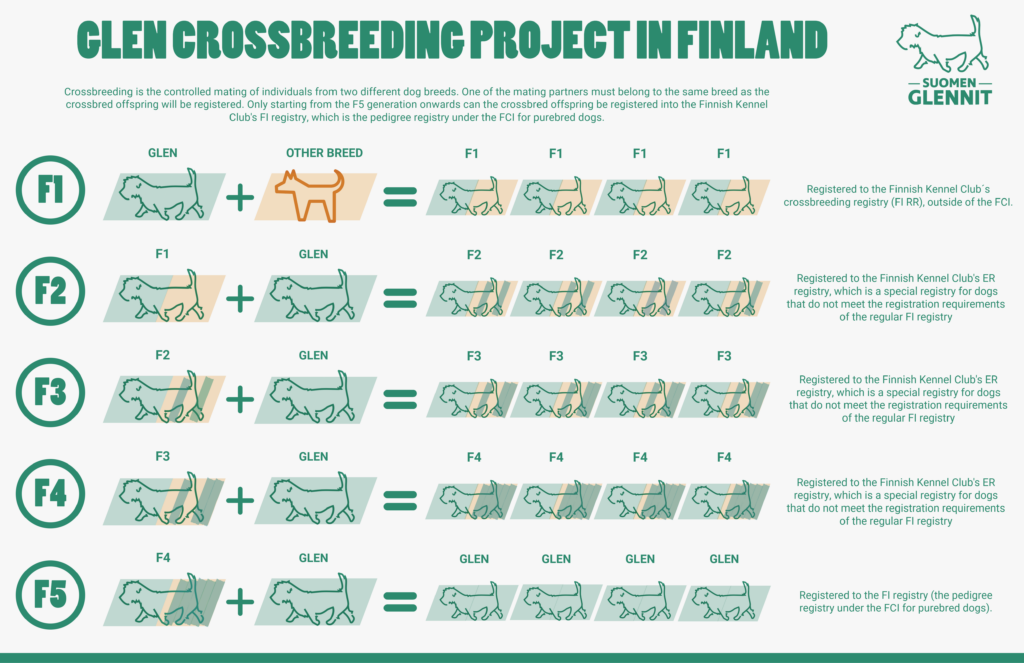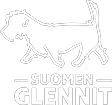At the annual general meeting of the Finnish Glen Association held on March 26, 2024, the members voted to initiate the planning of the glen crossbreeding project in Finland and to begin preparing the application. The process is expected to be lengthy. Below, you will find details regarding the project steps and the progression of the matings.
Crossbreeding is a beneficial way to improve the health of a breed and reduce the risk of hereditary problems
Crossbreeding is a tool where individuals from two different breeds are crossbred in a careful and controlled manner. Crossbreeding aims to increase genetic diversity and decrease hereditary diseases and illnesses in breeds where genetic variation is lacking. The idea is that selected individuals from another breed bring health and good traits to a breed struggling with health problems and make the gene pool more versatile.
In Finland, the Finnish Kennel Club approves a crossbreeding project based on the application of the breed organization. The breed association or organization together with the breeders are responsible for the implementation of the project.
Ways in which crossbreeding can improve breed health:
- Genetic diversity: Crossbreeding increases genetic diversity, which can help reduce the adverse effects of inbreeding, such as hereditary diseases and defects.
- Reduction of diseases: Crossbreeding can help reduce the occurrence of hereditary diseases, such as hip and elbow dysplasia, eye diseases, and allergies/atopy.
- Diversity in temperament and behavior: Crossbreeding can also affect dogs’ behavior and temperament. By combining the characteristics of different breeds, desired traits can be achieved and the tendency towards hereditary behavioral problems reduced.
Crossbreeding can yield desirable results when performed carefully, systematically, and under strict supervision. The Finnish Kennel Club has established detailed guidelines for the implementation of crossbreeding projects, and the Kennel Club’s breeding committee is heavily involved in guiding and supervising both the planning and implementation of crossbreeding.
Steps of the crossbreeding project
Click on the image to open it as a PDF.

The steps of the project are also summarized below:
Preparation and Approval of the Crossbreeding Project Application
1. General Vote
The general assembly of the Finnish Glen Association decided to initiate the preparation of the crossbreeding application on March 26, 2024.
2. Application
The breeding committee of the Finnish Glen Association collaborates with the board to prepare the application, which must include a statement from the country of origin. The estimated duration of the phase is about a year.
3. Approvals – Part I
Approval of the application at the general assemblies of the breed association (Finnish Glen Association) and the breed organization (Finnish Terrier Organization). The estimated duration of the phase is months.
4. Approvals – Part II
The Finnish Terrier Organization presents the application for approval to the Finnish Kennel Club’s breeding committee, and subsequently, the application goes to the Kennel Club’s board for approval. The estimated duration of the phase is months.
5. Project Plan
Once the application is approved by the Finnish Kennel Club, the Finnish Glen Association prepares a detailed project plan, which requires approval from the Finnish Terrier Organization. The Finnish Terrier Organization presents the project plan to the Finnish Kennel Club for final approval. The estimated duration of the phase is about a year.
The timeframe for the described steps may span several years, depending on the speed of decision-making processes within the organizations. The project may fail at any stage of the approval process.
Implementation of the Crossbreeding Project and Registration of Crossbred Dogs
6. Implementation
The Terrier Organization may delegate the project’s implementation to the breed association. Breeders apply to the Finnish Kennel Club for permission to implement each litter according to the project plan. The individuals used for crossbreeding must meet the Finnish PEVISA requirements and JTO recommendations for their own breed. (PEVISA – Program for combating hereditary defects and diseases, JTO – Breed-specific breeding strategy)
7. Registration – F1
First-generation (F1) crossbred dogs are registered to the Finnish Kennel Club’s FI RR Crossbreeding Register, outside of the FCI.
8. Assessment
The Finnish Kennel Club, in collaboration with the breed organization or breed association, invites F1 offspring to an official behavior and conformation assessment once they reach two years of age or before planned breeding use.
9. Registration – F2
Second to fourth-generation (F2-F4) crossbred dogs may be registered to the Finnish Kennel Club’s ER registry (a special registry for dogs that do not meet FI registration criteria) by decision of the Finnish Kennel Club’s Breeding Committee based on a separate application.
10. Registration – F5
From the fifth generation (F5) onwards, crossbred offspring may be registered directly into the Finnish Kennel Club’s FI register (the pedigree registry for purebred dogs).
The estimated duration from F1 generation registration to F5 generation registration is 10-15 years.
What does crossbreeding mean?
Crossbreeding is the controlled mating of individuals from two different breeds. One of the mating partners must belong to the same breed as the crossbred offspring will be registered. Only starting from the F5 generation onwards can the crossbred offspring be registered to the Finnish Kennel Club’s FI registry, which is the pedigree registry under the FCI for purebred dogs.
The image below outlines the mating process within the crossbreeding project.

Have questions on your mind? Ask us!
We understand that crossbreeding raises many thoughts and questions. Don’t ponder alone; instead, send us your questions anonymously through this form. We’ll address them collectively and compile the questions and answers on our website.
***
Sources:
The Finnish Kennel Club´s Crossbreeding Instructions. May 4, 2023. Available in Finnish at: https://www.kennelliitto.fi/lomakkeet/roturisteytysohje?fbclid=IwAR1h758JwVtRt5wdCelw63uJidWntQ54NO-pe9x2vZwocjfiSI14Rs5fKs8_aem_AQ4QY4yIwu0vH1G3-EcnxerMUltjQ5wFae5XuNUuF7kuztqxjw1a10p56cw9sCoxvHk8AKgmCOn41rgeNp5Xo_xK )
The Finnish Kennel Club 1.6.2023. Crossbreeding instructions and project plan updated. Available in Finnish at: https://www.kennelliitto.fi/tietoa-meista/uutiset/roturisteytysohjetta-ja-projektisuunnitelmaa-paivitetty
The Finnish Kennel Club. Crossbreeding: https://www.kennelliitto.fi/en/breeding-and-health/cross-breeding (visited on 31.3.2024)
Kirsi Sainio 7.12.2021. Crossbreeding can help alleviate bottlenecks in dog breeding. Available in Finnish at: https://www.kennelliitto.fi/tietoa-meista/blogi/roturisteytyksista-voi-olla-apua-koiranjalostuksen-pullonkauloille (visited on 23.11.2023)
Mäki, K. & Kempe, R. 2023. The enhancing enforcement of animal protection legislation related to animal breeding: Part III: Problems of dog breeding and control criteria for authorities. Natural resources and bio-economy studies 16/2023. Natural Resources Institute Finland. Helsinki. 154 p.
